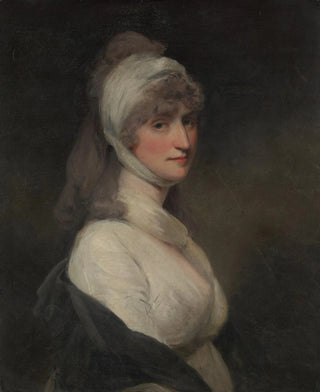Art print | Mme Thomas Pechell Charlotte Clavering passed away in 1841 - John Hoppner


View from behind

Frame (optional)
The artwork "Mme Thomas Pechell Charlotte Clavering died in 1841" by John Hoppner is a true testament to the elegance and sophistication of early 19th-century British painting. Capturing the essence of a bygone era, this portrait immerses us in the intimacy of a woman whose gaze seems to tell a story. The charm of this piece lies not only in the faithful representation of its subject but also in how Hoppner manages to convey subtle emotions through delicate features and a carefully chosen color palette. As you contemplate this painting, the viewer is invited to explore the nuances of humanity, while being transported to a world where art and life meet harmoniously.
Style and uniqueness of the work
John Hoppner's style is distinguished by his ability to combine realism and romanticism. In "Mme Thomas Pechell Charlotte Clavering died in 1841," the artist employs painting techniques that highlight the texture of the clothing and the luminosity of the skin, creating an atmosphere that is both intimate and majestic. The meticulous details, such as the reflections in the protagonist's eyes or the folds of the fabric, demonstrate impressive technical mastery. Hoppner skillfully plays with light, directing it adeptly to accentuate facial features and bring the character to life. This artwork also stands out for its framing, which places Charlotte Clavering at the center of attention while subtly blurring the background, adding depth and dimension that captivate the eye.
The artist and his influence
John Hoppner, born in 1758, is one of the most prominent portraitists of his time, rivaling artists such as Sir Joshua Reynolds. His career, marked by a wide variety of subjects and styles, reflects his ability to adapt to the tastes of his contemporaries while maintaining a personal signature. Hoppner succeeded in capturing not only the appearance of his models but also their character, social status, and personality. His influence on British painting is undeniable, as he contributed

Matte finish

View from behind

Frame (optional)
The artwork "Mme Thomas Pechell Charlotte Clavering died in 1841" by John Hoppner is a true testament to the elegance and sophistication of early 19th-century British painting. Capturing the essence of a bygone era, this portrait immerses us in the intimacy of a woman whose gaze seems to tell a story. The charm of this piece lies not only in the faithful representation of its subject but also in how Hoppner manages to convey subtle emotions through delicate features and a carefully chosen color palette. As you contemplate this painting, the viewer is invited to explore the nuances of humanity, while being transported to a world where art and life meet harmoniously.
Style and uniqueness of the work
John Hoppner's style is distinguished by his ability to combine realism and romanticism. In "Mme Thomas Pechell Charlotte Clavering died in 1841," the artist employs painting techniques that highlight the texture of the clothing and the luminosity of the skin, creating an atmosphere that is both intimate and majestic. The meticulous details, such as the reflections in the protagonist's eyes or the folds of the fabric, demonstrate impressive technical mastery. Hoppner skillfully plays with light, directing it adeptly to accentuate facial features and bring the character to life. This artwork also stands out for its framing, which places Charlotte Clavering at the center of attention while subtly blurring the background, adding depth and dimension that captivate the eye.
The artist and his influence
John Hoppner, born in 1758, is one of the most prominent portraitists of his time, rivaling artists such as Sir Joshua Reynolds. His career, marked by a wide variety of subjects and styles, reflects his ability to adapt to the tastes of his contemporaries while maintaining a personal signature. Hoppner succeeded in capturing not only the appearance of his models but also their character, social status, and personality. His influence on British painting is undeniable, as he contributed






